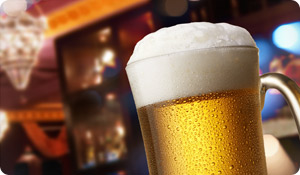
Researchers have known for quite some time that drinking moderate amounts of alcohol can help stabilize the bones of older men and women. But after digging a little deeper, scientists found that beer has a more protective effect than wine or liquor.
In the earlier part of your life, your goal is to pump lots of calcium into your growing bones so that you build a strong skeletal structure. As you age, the goal—and the challenge—is to hold on to that calcium so you don't end up with bone-thinning diseases like osteoporosis that are responsible for so many falls and fractures in old age. While it is normal for calcium to move in and out of your bones as it is used for other body processes, many of the diet and lifestyle choices you make throughout your life affect how much of this essential mineral is leached out and how much is replaced.
A Tufts University study of more than two thousand men and women, published in a 2009 issue of the American Journal of Clinical Nutrition, reported significantly better bone density measurements in both beer and wine drinkers than in those who drank liquor. But a follow-up study published by researchers at the University of California, Davis, in the February 2010 issue of the Journal of the Science of Food and Agriculture indicated that beer may be best.
Why is beer better? Thanks to the brewing process, some beers contain concentrated amounts orthosilicic acid (OSA), a form of the mineral silicon that is extracted in the liquid from the grain mash that is then used to make beer. Silicon, found in varying amounts in most grains and some fruits and vegetables, is thought to play a beneficial role in bone and connective tissue health in humans. OSA is an easily absorbed form of silicon, which makes it especially useful.
When it comes to building bones, however, all beers are not equal: When the researchers tested the silicon content of 100 different types of beer they found a range of 6.4 to 56.5 mg/liter. Pale malted ales and lagers brewed from hops or malted barley are the richest sources of OSA, with hop beers having as much as four times the silicon of malt beers. Darker beers and stouts brewed from roasted barley and black malt have much lower levels of OSA. Wheat beers contain little to no silicon at all because what silicon there is in the grain doesn't make it into the beer.
For the most part, moderate amounts of alcohol, meaning one or two drinks a day, have not been shown to cause harm to otherwise healthy people. On the contrary, research continues to reveal more and more health benefits of one sort or another. Still, most medical experts won't recommend picking up an alcohol habit for any reason, especially if you don't already imbibe. If you like the taste of beer but you're not a drinker, there's news for you, too: Non-alcoholic beers contain less silicon, but the form it takes is equally well absorbed.
Sources:
Tufts University: Drink and Be Strong
http://tuftsjournal.tufts.edu/2009/03_2/features/03/
Science Daily: Beer is a Rich Source of Silicon and May Help Prevent Osteoporosis
http://www.sciencedaily.com/releases/2010/02/100208091922.htm
Eureka Science News: Research Reveals Link Between Beer and Bone Health
http://esciencenews.com/articles/2010/02/08/research.reveals.link.between.beer.and.bone.health.
U.S. Department of Agriculture: Silicon: An Essential Nutrient
http://www.ars.usda.gov/News/docs.htm?docid=9264
PubMed:
British Journal of Nutrition (2009; abstract): The comparative absorption of silicon from different foods and food supplements
British Journal of Nutrition (2004; abstract( The silicon content of beer and its bioavailability in healthy volunteers)





